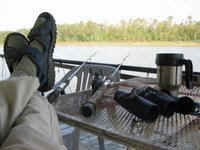
Emperor Napoleon Bonaparte (Felis) is one of our cats. At right he is doing his "I can do anything a stupid crawfish can do" immitation. He chose this name for himself after trying several others that just didn’t fit well enough. He was abandoned in a parking lot in Baton Rouge as a between-kitten-and-young-cat, and we picked him up and brought him to Butte La Rose. We had two other cats at the time, both large males (sort of). When the new cat first saw the two others, he found the first shelter available and hid under it for several minutes. Noticing that the other cats didn’t seem ready to kill and eat him, he came out and sniffed around until he became more comfortable with the place. He weighed about four pounds I guess, and still had his hormone factories dictating his understanding of his place in the pecking order that included the other two cats. He pretty quickly assumed that his place was at the top of the hierarchy. A few days later his factories were retired for life, but he still tried to intimidate the other cats. They kind of tolerated him, all four pounds of him. It looked funny because Alcibiades, one of the others, weighs 20 pounds. But the more he seemed to think he was lord of all he saw, the more the name Napoleon Bonaparte seemed to fit. And it stuck, and he is Napoleon.
It became evident to us that Napoleon didn’t seem to have the aversion to water that you expect in cats. He walked right out on the dock, over 16 feet of gangplanks, the first time we took him to the river. He seemed to spend a lot of time looking curiously at the water, and trying to catch things as they floated by on the current. Next thing you knew, he jumped in my boat and investigated everything in it. I was ready to run the trotline about then, so I just untied the boat and off we went together out on the river. He seemed perfectly calm about the whole thing. I must admit I thought maybe we had acquired a mentally subnormal cat. On the way back across the river, after running the line and giving him a small catfish to eat, he stood on the front of the boat with his tail swishing around and tried to catch the paddle as it swung forward and back. Without anthropomorphizing too much, he seemed happy to be out on the boat. When we got back to the dock, he didn’t even jump out of the boat right away. Very different, for a cat. This summer I took him out when I should have known it would be too hot for him in the open boat, and about the middle of the river he started to sound pretty pitiful. I thought, oh well, and picked him up under the shoulders, back legs hanging straight down, facing away from me, not struggling, and sunk him into the river up to his ears. Before he could fuss, I set him back in the boat. He actually acted relieved! About fifteen minutes later, he got hot again and I did the same thing again, and he still didn’t struggle. Weird. He usually rides in the boat with me now whenever he and I are both at the dock at the same time.
Some people may recognize the catfish as a gafftop, mor

e usually seen in salt water than in the Atchafalaya. But each summer I catch several of them on the trotline, and this summer I caught more of them than ever – as many as five on the trotline at one time. Not real big ones, most about the size you see here. I have done salinity testing on the river when these marine fishes are being caught and there seems to be no evidence of salt in the water.
The river is at 4.3 feet at the Butte La Rose gauge, little change over the past few days, but we should get at least a foot and a half more in the next week. The Mississippi will keep the rise going for a while, but the Ohio has lost its steam and isn’t offering much to keep the rise going.
Rise and shine, Jim
 mallmouth buffalo (Napoleon’s appetite here exceeds his abilities). When you bring these fish to the top in a current like this they sometimes spin like a whirligig held in the wind, and you see why the swivel is where it is. How in the world do these animals search and find food in a current like this? And yet, they will bite until and beyond the time you can’t fish the line anymore because it’s too tight.
mallmouth buffalo (Napoleon’s appetite here exceeds his abilities). When you bring these fish to the top in a current like this they sometimes spin like a whirligig held in the wind, and you see why the swivel is where it is. How in the world do these animals search and find food in a current like this? And yet, they will bite until and beyond the time you can’t fish the line anymore because it’s too tight.













